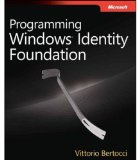The Table of Content of Programming Windows Identity Foundation
Various readers asked me to provide the table of content of Programming Windows Identity Foundation, so here it is. The formatting is not perfect, but I wanted to make sure to keep the page numbers and indentation so that you can assess how much space has been dedicated to any given topic you want to study.
I won’t repeat here what I wrote in the book intro (available also in this Microsoft Press post), but I do want to add a couple of notes.
1. Although the topics covered by the book are a superset of the ones in the training kit, it’s hard to make comparisons. The book packs information at much higher density and goes significantly deeper than the kit. Apart from something in Part I there are no step-by-step instructions, as you can expect from a title in the Developer Pro References series.
2. Apart from the parts explaining protocols and patterns, all the book is firmly anchored in code and gives very concrete guidance on how to implement the topic at hand. The only exception is Chapter 7: that chapter covers topics for which there are no official bits yet, and giving cove would have meant filling pages and pages of custom tactical code which could have become obsolete soon. What you get in chapter 7 is an intro to the topics (for example there are swimlane diagrams for OAuth 2 and similar) which helps you to wrap your head around the issue should you have to cope with it before official solutions arise. The exception to the exception is the part about MVC, where I do provide the code of a very simple and elegant solution (I wasn’t the one coming up with it :-)) which integrates really well with the MVC model.
And now, without further ado, the TOOOC ♪♬
Table of Contents
Foreword xi
Acknowledgments xiii
Introduction xvii
Part I Windows Identity Foundation for Everybody
1 Claims-Based Identity 3
What Is Claims-Based Identity? 3
Traditional Approaches to Authentication 4
Decoupling Applications from the Mechanics of Identity and Access 8
WIF Programming Model 15
An API for Claims-Based Identity 16
WIF’s Essential Behavior 16
IClaimsIdentity and IClaimsPrincipal 18
Summary 21
2 Core ASP.NET Programming 23
Externalizing Authentication 24
WIF Basic Anatomy: What You Get Out of the Box 24
Our First Example: Outsourcing Web Site Authentication to an STS 25
Authorization and Customization 33
ASP.NET Roles and Authorization Compatibility 36
Claims and Customization 37
A First Look at <microsoft.identityModel> 39
Basic Claims-Based Authorization 41
Summary 46
Part II Windows Identity Foundation for Identity Developers
3 WIF Processing Pipeline in ASP.NET 51
Using Windows Identity Foundation 52
WS-Federation: Protocol, Tokens, Metadata .54
WS-Federation 55
The Web Browser Sign-in Flow 57
A Closer Look to Security Tokens 62
Metadata Documents 69
How WIF Implements WS-Federation 72
The WIF Sign-in Flow .74
WIF Configuration and Main Classes 82
A Second Look at <microsoft.identityModel> .82
Notable Classes 90
Summary 94
4 Advanced ASP.NET Programming .95
More About Externalizing Authentication 96
Identity Providers ……………………………………..97
Federation Providers .99
The WIF STS Template .102
Single Sign-on, Single Sign-out, and Sessions 112
Single Sign-on ……………………………………….113
Single Sign-out .115
More About Sessions .122
Federation .126
Transforming Claims 129
Pass-Through Claims 134
Modifying Claims and Injecting New Claims 135
Home Realm Discovery .135
Step-up Authentication, Multiple Credential Types, and Similar Scenarios .140
Claims Processing at the RP 141
Authorization 142
Authentication and Claims Processing 142
Summary 143
5 WIF and WCF 145
The Basics 146
Passive vs.Active 146
Canonical Scenario 154
Custom TokenHandlers 163
Object Model and Activation 167
Client-Side Features 170
Delegation and Trusted Subsystems 170
Taking Control of Token Requests 179
Summary 184
6 WIF and Windows Azure 185
The Basics 186
Packages and Config Files 187
The WIF Runtime Assembly and Windows Azure …………….188
Windows Azure and X.509 Certificates 188
Web Roles 190
Sessions 191
Endpoint Identity and Trust Management 192
WCF Roles 195
Service Metadata 195
Sessions 196
Tracing and Diagnostics 201
WIF and ACS 204
Custom STS in the Cloud 205
Dynamic Metadata Generation 205
RP Management 213
Summary 213
7 The Road Ahead .215
New Scenarios and Technologies 215
ASP.NET MVC 216
Silverlight .223
SAML Protocol 229
Web Identities and REST .230
Conclusion .239
Index 241


Great stuff!
Thank you for sharing